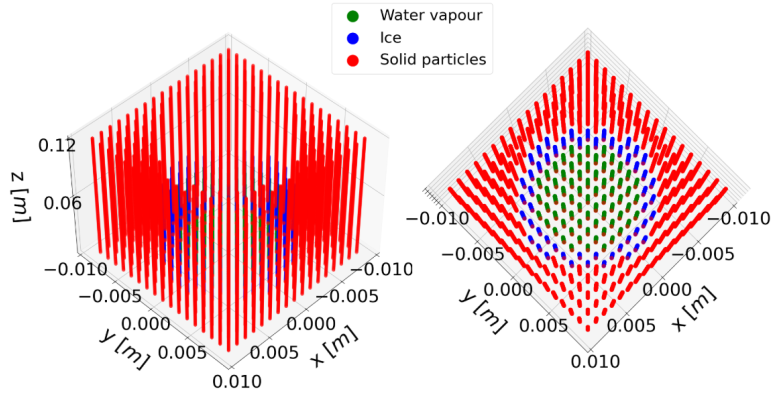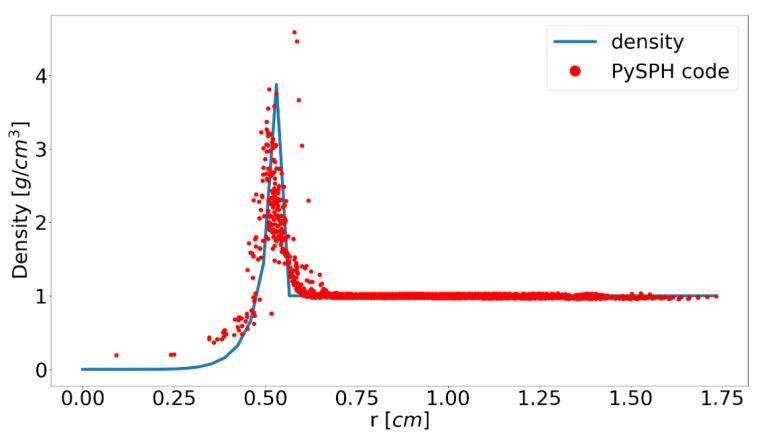- 1INAF-IAPS, Via del Fosso del Cavaliere, 100, 00133 Roma (luca.maggioni@inaf.it)
- 2Department of Physics, University of Roma Tor Vergata, Via della Ricerca Scientifica, 1, Roma 00133, Italy
- 3Department of Physics, University of Campania Luigi Vanvitelli, Viale Abramo Lincoln, 5, 81100 Caserta, Italy
Introduction
The ESA ExoMars Rover mission will have the task of investigating the Martian soil down to 2 meters providing a physical and chemical characterization of the shallow subsurface by means of an extensible drill [1,2]. For understanding how the drilling activities can affect the already tricky interplay between hydrodynamical and thermal processes that govern the distribution of hypothetical volatile material in the subsurface, numerical models are required. We present preliminary results concerning the evolution of a mixture of ice and water vapour located at a variable depth in the Mars' subsurface through a Smoothed Particle Hydrodynamics (SPH) approach [3]. In addition to show the importance of modelling various physical phenomena like phase transitions and dynamical interactions, we propose a novel approach which consists in coupling the SPH code with Eulerian codes to account for the influence of the drilling activity on the thermal state of the borehole walls.
Methods
Simulations are performed with the help of PySPH [4], an open-source and Python-based framework for SPH. Using a number of pseudo-particles between 20000-30000, we generate a cylindrical fracture with a diameter of about 14 mm and a depth of 12 cm, in which we typically set a layer of ice and water vapour of about 6 cm as shown in Fig.1. The real depth of the hole is computationally unsustainable in the development phase, since it would require a huge number of particles (about 500000) and, consequently, very long simulations. At this point, besides to numerically integrate the hydrodynamics equations that govern the time evolution of the velocity, density, and thermokinetic energy of our multi-component fluid, we need to implement reasonable physical approximations to treat all the other phenomena. Ice-vapour phase transitions are taken into account via a statistical approach by considering the possible sublimation and deposition both for particles in flight and those interacting with Mars' surface. Moreover, dynamical interactions with the internal and external solid boundaries are implemented through a proper mirroring scheme.
In the next steps, we will incorporate into the framework the effects due to the Solar radiation, the viscous drag between solid and gaseous particles, and the heat released on the borehole walls during the drilling operations. For this aim, we assign a temperature gradient to the solid particles of the fracture exploiting the output of an Eulerian code [5].

Figure 1: Typical initial conditions.
Preliminary results
In order to test our code, we applied it to two basics problems: a gas sphere expanding adiabatically in space and a classical three-dimensional shock wave expansion. In the first case our results reproduced satisfactorily the analytical profile of a homologous expansion, while in the second case we found a good agreement both with the analytical solution proposed by Sedov [6] and other Lagrangian codes [7,8]. In Fig.2, the comparison is illustrated between the density profile obtained within our simulation using 100000 pseudo-particles and the analytical counterpart.
Currently, the multi-component fluid is influenced solely by dynamical and thermal interactions with the boundary, as well as by phase transitions, in which we included also the contribution due to the latent heat. In particular, after the inclusion of each effect, we ensured that fundamental conservation laws, such as energy conservation, were fulfilled.

Figure 2: Density profile as a function of the radial distance at a time t = 0.2 s.
Acknowledgments
This work is supported by INAF-IAPS within the project "ExoMars".
Bibliography
[1] A. Coradini et al. “MA_MISS: Mars multispectral imager for subsurface studies”. In: Advances in Space Research 28 (2001), pp. 1203–1208. DOI: 10.
1016/S0273-1177(01)00283-6.
[2] J. Vago et al. “Habitability on Early Mars and the Search for Biosignatures with the ExoMars Rover”. In: Astrobiology 17 (2017), pp. 471–510.
DOI: 10.1089/ast.2016.1533.
[3] J. J. Monaghan. “Smoothed particle hydrodynamics”. In: Reports on Progress in Physics 68.8 (2005), pp. 1703–1759.
DOI: 10.1088/0034-4885/68/8/R01.
[4] P. Ramachandran et al. “PySPH: A Python-based Framework for Smoothed Particle Hydrodynamics”. In: ACM Transactions on Mathematical Soft-
ware 47.4 (2021), pp. 1–38. issn: 1557-7295. DOI:10.1145/3460773.
[5] M. Formisano et al. “Subsurface Thermal Modeling of Oxia Planum, Landing Site of ExoMars 2022”. In: Advances in Astronomy 2021 (2021). DOI: 10.
1155/2021/9924571.
[6] L.I. SEDOV. “CHAPTER IV - One-Dimensional Unsteady Motion of a Gas”. In: Similarity and Dimensional Methods in Mechanics. Ed. by L.I.
SEDOV. Academic Press, 1959, pp. 146–304. isbn: 978-1-4832-0088-0. DOI: https : / / doi . org / 10 .1016/B978-1-4832-0088-0.50011-6.
[7] L. D. Pinto et al. “Self-gravitating disks in binary systems: an SPH approach: I. Implementation of the code and reliability tests”. In: Astronomy amp;
Astrophysics 628 (2019), A82. issn: 1432-0746. DOI:10.1051/0004-6361/201833143
[8] S. Rosswog et al. “MAGMA: a three-dimensional, Lagrangian magnetohydrodynamics code for merger applications”. In: Monthly Notices of the
Royal Astronomical Society 379.3 (2007), pp. 915–931. issn: 1365-2966. DOI: 10.1111/j.1365-2966.2007.11984.x.
How to cite: Maggioni, L., Teodori, M., Magni, G., Formisano, M., De Sanctis, M. C., and Altieri, F.: Volatile emissions from planetary fractures through a smoothed-particle hydrodynamics approach: the case of Mars, Europlanet Science Congress 2024, Berlin, Germany, 8–13 Sep 2024, EPSC2024-312, https://doi.org/10.5194/epsc2024-312, 2024.